Opioid metabolism: new treatment and diagnosis pathways

Opiates are substances derived from the seed of the dream herb. The best known are morphine for its analgesic power and heroin for its importance in drug addiction. However, the substances in this group are also used in treatments that have nothing to do with those mentioned above, such as antitumbal or diarrheal medicines. Our body synthesizes opioid-like acting substances, most of which are peptides called internal opioid peptides. As with opiates, analgesia is the best known function of opioid peptides, but today we know that they have many other functions such as hormonal secretion, brain development, digestion, etc.
An important part of the control of the activity of internal opioid peptides is done through its hydrolysis, that is, breaking its amino acid chain. The general objective of our group is to analyze the importance of this rupture in the physiological and pathological episodes in which opioid peptides intervene. The works carried out so far belong to the basic scientific field. Opioid rupture has been shown to be related to brain development, hormone secretion, and depressive treatment. The two projects we are currently developing are on the road to applied science.
One of them examines whether opioid drug addiction (heroin or morphine) and withdrawal syndrome affect enzymes that catalyze the breakdown of brain peptides. Animal models of dependence and withdrawal syndrome are created for this purpose. If the relationship between opioid metabolism and opioids was confirmed, the pathway for the synthesis of new drugs to treat pain and withdrawal syndrome could be opened. In this sense, it would be interesting to develop specific inhibitory enzymes that catalyze opioid rupture and have to do with dependency and withdrawal processes.
The second project, which is developed in collaboration with the Clínica Euskalduna in Bilbao, analyzes the importance of the opioid metabolism of human seed in human fecundity. The metabolism of opioid peptides in the human seed is much higher than in other tissues and fluids and may be associated with certain fertility parameters in growth. This paper analyzes whether there is a relationship between enzymes that break the pathology of seeds and opioid peptides. The finding of the existence of this link may affect the diagnosis and treatment of infertility. Our intention is to investigate whether it is related to these enzymes and other diseases of the male reproductive system.





